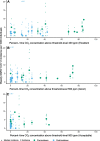SARS-CoV-2 incidence in secondary schools; the role of national and school-initiated COVID-19 measures
- PMID: 37370045
- PMCID: PMC10294357
- DOI: 10.1186/s12889-023-16146-0
SARS-CoV-2 incidence in secondary schools; the role of national and school-initiated COVID-19 measures
Abstract
Introduction: Our aim was to gain insight into the effect of COVID-19 measures on SARS-CoV-2 incidence in secondary schools and the association with classroom CO2 concentration and airborne contamination.
Methods: Between October 2020-June 2021, 18 schools weekly reported SARS-CoV-2 incidence and completed surveys on school-initiated COVID-19 measures (e.g. improving hygiene or minimizing contacts). CO2 was measured in occupied classrooms twice, and SARS-CoV-2 air contamination longitudinally using electrostatic dust collectors (EDC) and analyzed using RT-qPCR. National COVID-19 policy measures varied during pre-lockdown, lockdown and post-lockdown periods. During the entire study, schools were recommended to improve ventilation. SARS-CoV-2 incidence rate ratios (IRR) were estimated by Generalized Estimating Equation (GEE) models.
Results: During 18 weeks follow-up (range: 10-22) SARS-CoV-2 school-incidence decreased during national lockdown (adjusted IRR: 0.41, 95%CI: 0.21-0.80) and post-lockdown (IRR: 0.60, 0.39-0.93) compared to pre-lockdown. School-initiated COVID-19 measures had no additional effect. Pre-lockdown, IRRs per 10% increase in time CO2 exceeded 400, 550 and 800 ppm above outdoor level respectively, were 1.08 (1.00-1.16), 1.10 (1.02-1.19), and 1.08 (0.95-1.22). Post-lockdown, CO2-concentrations were considerably lower and not associated with SARS-CoV-2 incidence. No SARS-CoV-2 RNA was detected in any of the EDC samples.
Conclusion: During a period with low SARS-CoV-2 population immunity and increased attention to ventilation, with CO2 levels most of the time below acceptable thresholds, only the national policy during and post-lockdown of reduced class-occupancy, stringent quarantine, and contact testing reduced SARS-CoV-2 incidence in Dutch secondary schools. Widespread SARS-CoV-2 air contamination could not be demonstrated in schools under the prevailing conditions during the study.
Keywords: Air contamination; CO2 concentration; COVID-19 measures; SARS-CoV-2; Secondary schools.
© 2023. The Author(s).
Conflict of interest statement
The authors declare that they have no competing interests.
Figures





References
-
- Zhang D, Ding E, Bluyssen PM. Guidance to assess ventilation performance of a classroom based on CO2 monitoring. Indoor Built Environ. 2022;31(4):1107–1126. doi: 10.1177/1420326X211058743. - DOI
Publication types
MeSH terms
Substances
LinkOut - more resources
Full Text Sources
Medical
Miscellaneous

